Microsoft Power Apps and OutSystems are low-code development platforms that allow organizations to create custom applications with reduced reliance on traditional programming.
Power Apps
Power Apps is a suite of apps, connectors, and a data platform from Microsoft that allows users to create custom applications without the need for traditional coding. It’s part of the Microsoft Power Platform, which also includes Power BI for business analytics and Power Automate for workflow automation. It’s often used for tasks such as creating internal business apps, automating workflows, and improving overall productivity within an organization.
OutSystems
OutSystems is a low-code application development platform that enables organizations to build, deploy, and manage web and mobile applications quickly and with minimal hand-coding and manual programming. With its visual development environment, developers can focus on application logic and functionality, rather than on coding intricacies.
Differences – Power Apps and OutSystems
1. Platform
Power Apps: Developed by Microsoft, Power Apps is part of the Microsoft Power Platform, which includes Power BI for business analytics and Power Automate for workflow automation.
OutSystems: OutSystems is a standalone platform developed by the company OutSystems.
2. Flexibility and Customization
Power Apps: Offers flexibility in creating both canvas apps and model-driven apps. Apps can be customized with a visual interface and data can be stored via the Common Data Service.
OutSystems: Provides flexibility in creating web and mobile applications with a visual development environment. In terms of business logic and user interface, it allows for greater customization.
3. User-Friendly Interface
Power Apps: Known for its intuitive and user-friendly interface, Power Apps allows users to create applications using a visual design approach. An easy-to-use drag-and-drop interface and prebuilt components contribute to a smooth development process.
OutSystems: Although OutSystems accelerates low-code development, its interface may be more complex to navigate for new users, potentially slowing down development.
4. Integration
Power Apps: Easily integrates with other Microsoft products like SharePoint, Office 365, and Dynamics 365. It also supports connectors for various external services such as SAP, Salesforce, Twitter, Dropbox, Google services, and more.
OutSystems: Connects to a variety of data sources, APIs, and external systems through built-in connectors.
Why is Microsoft Power Apps better than OutSystems?
- Power Apps and OutSystems supports integration with external services, but Power Apps has a stronger integration with the Microsoft ecosystem.
- Microsoft Power Apps has the potential to transform business operations by offering a flexible, user-friendly, and cost-effective solution for creating tailored applications that align closely with specific organizational requirements.
- Favourable community of coworkers and free online tutorials exist for the Microsoft power platform, but OutSystems lacks online support and community forums.
- By integrating AI capabilities, Power Apps users can improve the decision-making process within their applications.
- Microsoft supports NCLC power platform with common functionalities such as convert to pdf, export to excel, sending mail through outlook, however OutSystems platform lacks such common functionalities and hence, it is less favoured by business users.
About PositiveEdge
PositiveEdge is the Certified Microsoft Power Platform Partner in India.
Power Apps is widely used for various business scenarios, including process automation, data collection, project management, and customer relationship management. PositiveEdge is a Microsoft Power Apps Partner in India, USA and UAE. For more information, contact us now.
